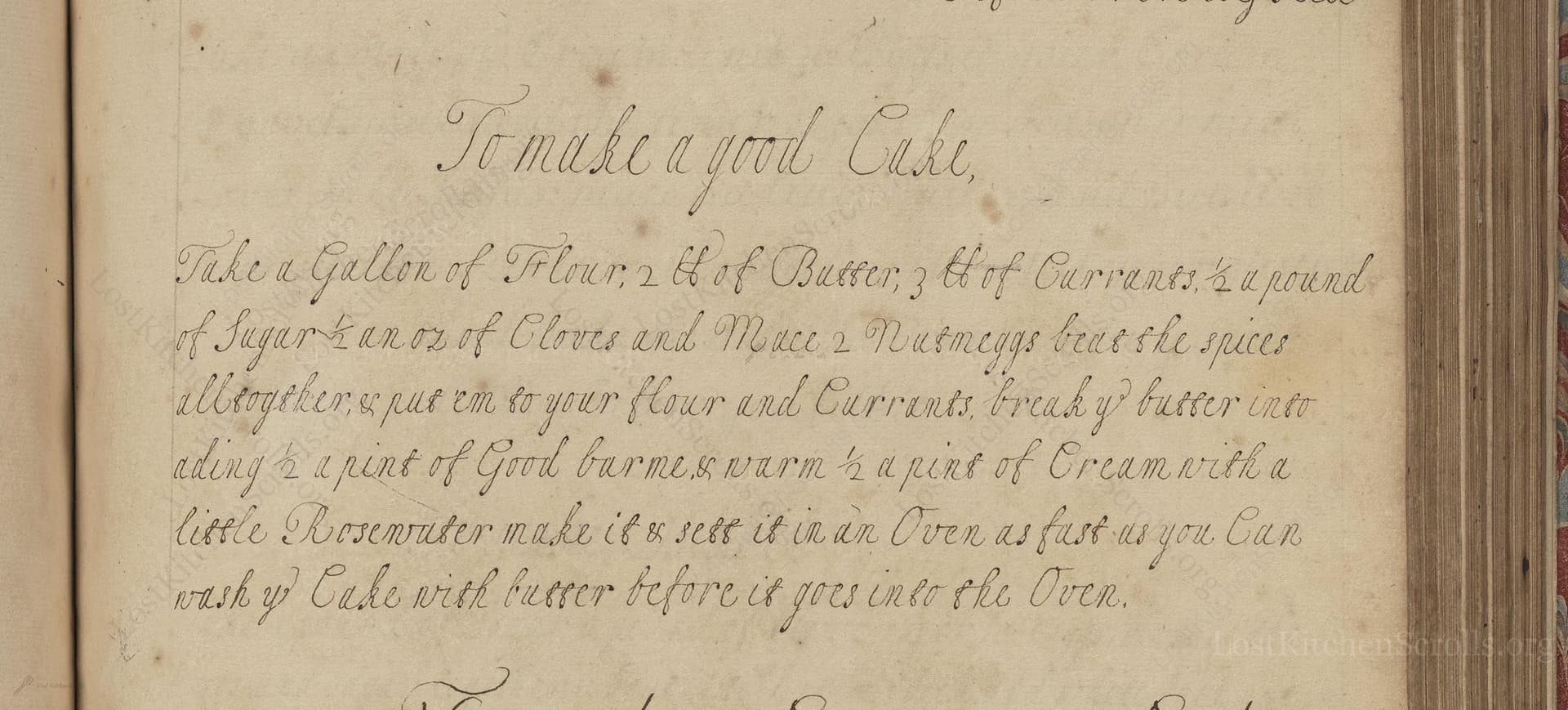To Make A Good Cake
From the treasured pages of Cookery and medicinal recipes of M.W.
Unknown Author

To Make A Good Cake
"Take a Gallon of Flour, 2 lb of Butter, 3 lb of Currants, ½ a pound of Sugar, ½ an oz of Cloves and Mace, 2 Nutmeggs beat the spices alltogether, & put em to your flour and Currants, break ye butterr into it, ading ½ a pint of Good barme, & warm ½ a pint of Cream with a little Rosewater make it & sett it in Oven as fast as you can wash ye Cake with butterr before it goes into the Oven."
Note on the Original Text
The recipe is typical of its era: short on specific instructions and precise measurements, and reliant on the cook's experience and intuition. Spelling like 'ye' (meaning 'the'), 'Currants', 'barme' (for barm, or ale yeast), and 'nutmeggs' reflect both the orthographic tendencies of early modern English and dialect influences. The method is a blend between bread and cake making, as cakes in this period were more like enriched, sweetened breads. Directions like 'set it in Oven as fast as you can' hint at both the importance of working quickly with yeast and the unpredictable nature of early baking environments.

Title
Cookery and medicinal recipes of M.W. (1775)
You can also click the book image above to peruse the original tome
Writer
Unknown
Era
1775
Publisher
Unknown
Background
A delightful glimpse into British kitchens of yesteryear, this manuscript collection—attributed simply to 'M. W.'—whisks readers through cherished recipes and culinary wisdom passed down between 1700 and 1850. A treasure trove for those who savor the artistry of historical cookery.
Kindly made available by
Folger Shakespeare Library
This recipe dates from the early 18th century, a time when cakes were dense, often yeast-leavened, and lavishly enriched with butter, sugar, and dried fruit. Written by 'M.W.' and recorded between 1700 and 1850, it comes from a household manuscript—part of the living culinary tradition before chemical leaveners like baking powder transformed baking. Such cakes were festive, reserved for celebrations or gatherings. The use of costly spices and imported currants signals its status as a showpiece for the well-off. Yeast-leavened cakes like this predate the rise of the modern, airy sponge cake.

Back then, the cake would have been made with large earthenware bowls for mixing, wooden spoons and hands for combining dough, and perhaps a mortar and pestle for grinding spices. Measuring tools were not standardized—quantity was judged by eye, hand, or local measures. Baking would have been done in a brick or stone oven, with cakes set directly on the oven floor or in a heavy metal or ceramic tin. A brush made of feather or linen, or even simple fingers, would have been used to glaze the cake with butter before baking.
Prep Time
40 mins
Cook Time
1 hr 10 mins
Servings
32
We've done our best to adapt this historical recipe for modern kitchens, but some details may still need refinement. We warmly welcome feedback from fellow cooks and culinary historians — your insights support the entire community!
Ingredients
- 10 lb plain flour
- 2 lb unsalted butter
- 3 lb currants
- 8 oz sugar (caster sugar is a good choice)
- 0.5 oz cloves (ground)
- 0.5 oz mace (ground)
- 2 whole nutmegs (grated, about 1/3 oz total)
- 1 1/4 cups heavy cream
- 1 tablespoon rosewater
- 1 1/4 cups good barm (fresh ale yeast), or substitute with 2 x 1/4 oz packets active dry yeast
- Extra melted butter for brushing
Instructions
- To make this historical cake with modern ingredients, start by preheating your oven to 350°F (175°C).
- In a large bowl, sift together 10 pounds of flour with 0.5 ounce each of ground cloves and mace, and 2 finely grated nutmegs.
- Add in 3 pounds of washed and dried currants, and 8 ounces of sugar.
- Cut in 2 pounds of unsalted butter until the mixture is crumbly.
- Warm 1 1/4 cups heavy cream with 1 tablespoon of rosewater until just lukewarm, and separately, prepare 1 1/4 cups of fresh yeast starter (or substitute with 2 standard packets of active dry yeast dissolved in the cream mixture).
- Add the yeast-cream mix to the flour mixture and knead into a soft, rich dough.
- Let it rise in a warm place until doubled.
- Shape into one or two large cakes, brush the top with melted butter, and bake in a buttered tin for about 60-80 minutes or until golden and cooked through.
- Let cool before serving.
Estimated Calories
635 per serving
Cooking Estimates
Preparing this historic cake takes about 40 minutes, including mixing, kneading, and letting the dough rise. Baking takes about 70 minutes. Each slice is a generous serving, so you can easily feed a crowd with it.
As noted above, we have made our best effort to translate and adapt this historical recipe for modern kitchens, taking into account ingredients nowadays, cooking techniques, measurements, and so on. However, historical recipes often contain assumptions that require interpretation.
We'd love for anyone to help improve these adaptations. Community contributions are highly welcome. If you have suggestions, corrections, or cooking tips based on your experience with this recipe, please share them below.
Join the Discussion
Rate This Recipe

Den Bockfisch In Einer Fleisch Suppen Zu Kochen
This recipe hails from a German manuscript cookbook compiled in 1696, a time whe...

Die Grieß Nudlen Zumachen
This recipe comes from a rather mysterious manuscript cookbook, penned anonymous...

Ein Boudain
This recipe comes from an anonymous German-language manuscript cookbook from 169...

Ein Gesaltzen Citroni
This recipe, dating from 1696, comes from an extensive anonymous German cookbook...
Browse our complete collection of time-honored recipes



